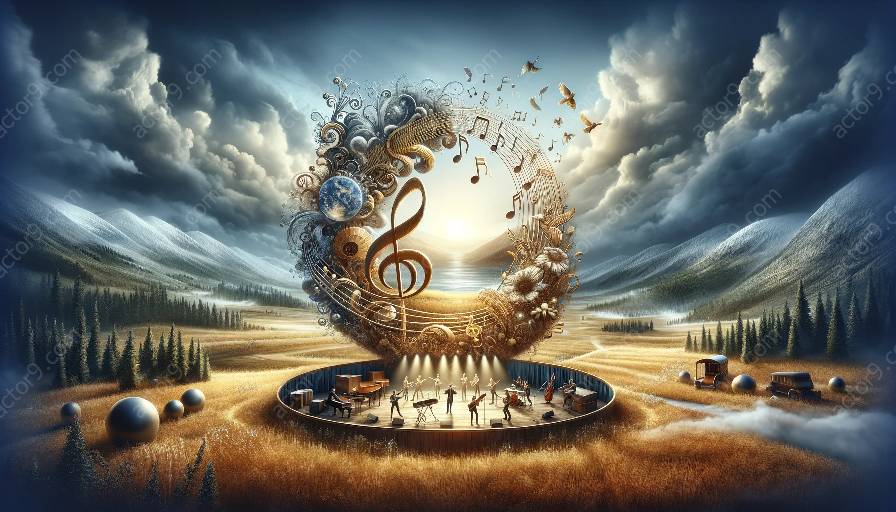When it comes to the world of circus performances, the role of music is often underestimated. However, the synchronization of music and circus acts plays a crucial role in creating an immersive, captivating experience for the audience. In this article, we'll delve into the intricate connection between music and circus arts, exploring how music enhances the visual spectacle, amplifies emotions, and synchronizes with acrobatic feats and other circus acts.
The Role of Music in Circus Performances
The role of music in circus performances is multi-faceted and goes well beyond just providing background noise. Music serves as a powerful tool that accentuates the visual elements of the circus, creating a seamless blend of auditory and visual experiences for the audience. The following are some key aspects depicting the essential role of music in circus performances:
- Emotional Enhancement: Music has the ability to intensify and evoke emotions, deepening the connection between the audience and the performers. Whether it's a heart-pounding drumbeat during a high-flying trapeze act or a whimsical tune accompanying a clown's antics, music sets the emotional tone for the entire performance.
- Rhythmic Coordination: The rhythmic structure of music provides a framework for timing and coordination among circus performers. It helps acrobats, jugglers, and other artists synchronize their movements, leading to seamless and visually stunning performances.
- Narrative Support: Music can reinforce the narrative or thematic elements of a circus act, effectively guiding the audience through a story or concept. Whether it's a suspenseful melody for a daredevil act or a lighthearted tune for comedic interludes, music aids in storytelling within the circus arena.
Synchronization of Music and Circus Acts
The synchronization of music and circus acts is a meticulously choreographed process that demands precision and harmony between the auditory and visual components of the performance. Here are some key points that highlight the significance of synchronized music and circus acts:
- Timing and Precision: Circus acts such as aerial performances, hand balancing, and contortion routines require impeccable timing and precision. The music serves as a guiding force, allowing performers to execute their acts with finesse and grace, enhancing the overall visual spectacle.
- Enhanced Atmosphere: Through synchronized music, the atmosphere of a circus performance is elevated, transporting the audience into the world of wonder and excitement. Whether it's an ethereal melody for an aerial silk performance or a lively tune for a tumbling routine, synchronized music immerses the audience in the magic of the circus.
- Impactful Climaxes: Music is instrumental in building up to and delivering impactful climactic moments within circus acts. By synchronizing crescendos, dramatic pauses, and tempo changes, music intensifies the suspense and thrill, leaving a lasting impression on the audience.
Exploring the Intersection of Music and Circus Arts
As we delve deeper into the relationship between music and circus arts, it becomes evident that the two are inseparable components of a mesmerizing performance. The following aspects further illuminate the intersection of music and circus arts:
- Musical Composition: Composers and music directors play a pivotal role in creating original soundtracks or selecting existing music that complements and elevates the artistry of circus performances. The composition of music is tailored to enhance specific acts, amplifying the visual impact and emotional resonance.
- Collaborative Rehearsals: Rehearsals for circus acts involve collaborative sessions where performers and musicians work closely to synchronize their movements and music, achieving a cohesive and harmonious production. This collaborative process fosters a deep integration of music and circus performances.
- Creative Innovation: Music and circus arts continually inspire each other, leading to innovative productions that push the boundaries of creativity and ingenuity. The fusion of different musical genres and circus disciplines results in captivating, boundary-defying performances.
Embracing the Synthesis of Music and Circus Acts
In conclusion, the synthesis of music and circus acts is a mesmerizing blend of auditory and visual artistry, captivating audiences with its seamless coordination and emotive power. The role of music in circus performances extends beyond mere accompaniment, intertwining with the very essence of circus arts to create unforgettable, immersive experiences for spectators. By embracing the intricate synchronization of music and circus acts, performers and audiences alike embark on a transcendent journey into the wondrous realm of the circus.


































